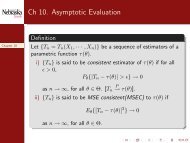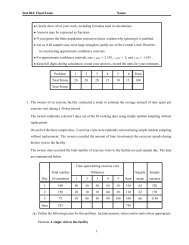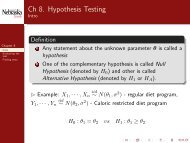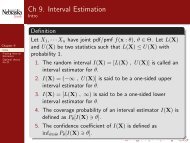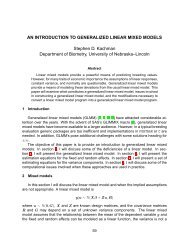Matvec Users’ Guide
Matvec Users' Guide
Matvec Users' Guide
- No tags were found...
You also want an ePaper? Increase the reach of your titles
YUMPU automatically turns print PDFs into web optimized ePapers that Google loves.
3.4. COMPUTATION 19<br />
3.3.3 Selecting elements<br />
Sometimes, you may want to select elements which satisfy certain condition. Here is an example:<br />
> A = [1,2,3;4,5,6]<br />
Col 1 Col 2 Col 3<br />
Row 1 1 2 3<br />
Row 2 4 5 6<br />
> A.select(A>2)<br />
i = 1 i = 2 i = 3 i = 4<br />
3 4 5 6<br />
3.4 Computation<br />
3.4.1 Friend function<br />
There are several standard math functions available. The details about the ranges and error conditions can<br />
be found in your math library reference manuals. They are implemented as friend functions of class Matrix.<br />
abs(A) acos(A) asin(A) atan(A) atan2(A,B)<br />
ceil(A) cos(A) cosh(A) erf(A) erfc(A)<br />
exp(A) floor(A) gammainc(A) gammaln(A,B) int(A)<br />
log(A) log10(A) max(A) max(A,B) min(A)<br />
min(A,B) mod(A,B) pow(A) round(A) sin(A)<br />
sinh(A) sqrt(A) tan(A) tanh(A)<br />
The above friend functions are performed element-by-element, and the relevant objects A and B remain<br />
intact.<br />
3.4.2 Member function<br />
For a convenience, the standard math functions are also implemented as member functions.<br />
A.abs() A.acos() A.asin() A.atan() A.atan2(B)<br />
A.ceil() A.cos() A.cosh() A.erf() A.erfc()<br />
A.exp() A.floor() A.gammainc() A.gammaln(B) A.int()<br />
A.log() A.log10() A.max() A.max(B) A.min()<br />
A.min(B) A.mod(B) A.pow() A.round() A.sin()<br />
A.sinh() A.sqrt() A.tan() A.tanh()<br />
A.gammaln() returns the log of the gamma function value of A. The gamma function is defined as<br />
Γ(x) =<br />
∫ ∞<br />
0<br />
t (x−1) e −t dt<br />
with Γ(1) = 1, Γ(1/2) = √ (π), and Γ(x + 1) = xΓ(x).<br />
A.gammainc() returns the incomplete gamma function value of A. The incomplete gamma function is<br />
defined as<br />
∫ x<br />
0<br />
gammainc(x, a) =<br />
t(a−1) e −t dt<br />
(a > 0)<br />
Γ(a)<br />
all<br />
A.all() operates over the columns of A, returning a vector of 1’s and 0’s. If A is a one-row or one-column<br />
matrix, then the returned value would be a scalar. For example,







